JavaScript has transformed from a simple scripting language into a vital component of modern web development. Each year brings new libraries, enhancements to existing ones, and opportunities for developers to expand their skill sets. If you find yourself relying heavily on jQuery in 2025, it might be a great moment to explore new options.

To stay competitive in the field, it’s important to be aware of the most relevant JavaScript libraries available. With so many choices, selecting the right ones can be challenging, and that’s exactly why this guide is here to assist you.
In the following sections, we’ll highlight 10 essential JavaScript libraries to know in 2025. These libraries are shaping the future of web development and will support you in building web applications, optimizing performance, and creating innovative AI-powered interfaces. Leveraging these tools can empower you to write better, faster, and more scalable code.
Here’s a bar chart showcasing the popularity trends of JavaScript libraries in 2025 based on industry survey data.
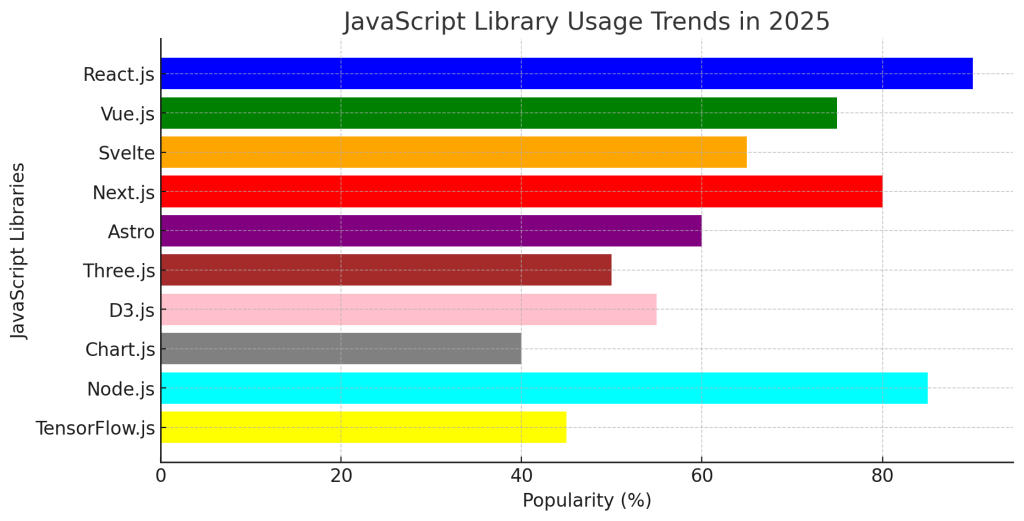
Key Insights from the Chart:
- React.js remains the most widely used JavaScript library (90% adoption).
- Node.js is still dominant in backend development (85%).
- Vue.js and Next.js continue to be strong contenders for frontend development.
- Astro is rapidly gaining traction due to its performance-first approach.
- Machine learning in JavaScript (TensorFlow.js) is still growing but not as widely adopted as core web libraries.
This visual helps you make informed choices when selecting a JavaScript library in 2025 based on industry trends.
1.React.js – The Evergreen Frontend Powerhouse
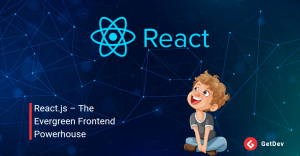
React.js has firmly established itself as one of the most important tools in modern frontend development. Since its release more than a decade ago, it has remained a dominant force in the web development world, continuously evolving and adapting to meet the needs of developers. Thanks to a combination of continuous updates, a large and active community, and a rich ecosystem, React.js has maintained its position at the top. Let’s take a deeper dive into why React.js continues to be such a powerful tool and explore what makes it stand out in 2025.
Why You Should Know It
React.js isn’t just another frontend framework—it’s the king of frontend development. Its widespread adoption is a testament to its effectiveness in building user interfaces (UIs) for web and mobile applications. It’s an open-source library created by Facebook (now Meta), which initially released it to solve the challenges they faced with building dynamic UIs for their large-scale applications. Over time, React.js has expanded beyond Facebook’s internal needs to become a global standard.
One of the key reasons React.js remains so popular is its community-driven development. The framework is continuously updated with new features, performance improvements, and bug fixes, ensuring that it keeps up with the latest trends and requirements of web development. In addition, its active community provides support, resources, and contributions to make it even better.
React.js is also highly scalable, making it ideal for projects ranging from small websites to large-scale web applications. Its component-based architecture encourages reusable code and modularity, making it easy to maintain and update large projects over time.
Key Features
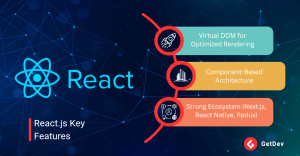
React.js comes packed with features that make it a go-to solution for frontend development.
- Virtual DOM for Optimized Rendering
React.js uses a Virtual DOM (Document Object Model), which allows the framework to efficiently update and render only the parts of the UI that have changed. This leads to faster and smoother rendering of the application, as it minimizes the number of updates to the actual DOM, which is a slower process. The Virtual DOM is one of the key reasons for React’s performance and scalability, especially for complex applications with lots of interactive elements.
- Component-Based Architecture
React.js follows a component-based architecture, meaning that the UI is broken down into smaller, reusable components. This modular approach allows developers to build applications in a more structured and maintainable way. Each component can have its own state and logic, making it easier to debug, test, and reuse code. By breaking the UI into smaller parts, React also promotes better organization and cleaner code.
- Strong Ecosystem (Next.js, React Native, Redux)
React’s ecosystem extends well beyond the core library. Tools like Next.js enable server-side rendering (SSR) and static site generation (SSG), improving the performance and SEO of React applications. React Native allows developers to build mobile applications for both iOS and Android using the same React.js principles, bringing the power of React to mobile development. Redux, another popular library in the React ecosystem, provides a predictable state container that makes managing application state easier and more scalable.
What’s New in 2025?
React.js continues to evolve, with new features and updates introduced regularly. Here’s a look at some of the most significant advancements coming in 2025.
- React Server Components Make SSR and Hydration Smoother
One of the most exciting new features in React.js for 2025 is React Server Components. These allow developers to build server-rendered components that can be streamed to the client, resulting in smoother server-side rendering (SSR) and more efficient hydration (the process of making a server-rendered page interactive). This advancement aims to improve performance and reduce the complexity of building React applications with SSR.
- Enhanced Concurrent Rendering for Ultra-Fast UI Updates
React 2025 brings improvements to concurrent rendering, which enables React to better prioritize rendering tasks. With concurrent rendering, React can keep the UI responsive, even during large data loads or complex computations, by breaking updates into smaller, prioritized chunks. This means that users will experience ultra-fast UI updates and a more fluid, responsive experience, even in large, complex applications.
- AI-Assisted Coding Features Integrated with Modern IDEs
React.js is integrating AI-assisted coding features into modern Integrated Development Environments (IDEs). These tools leverage artificial intelligence to provide real-time suggestions, error detection, and even code generation, helping developers write code faster and more accurately. As AI continues to advance, these tools will only become more powerful, making React development easier and more efficient.
When to Use It
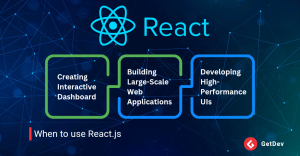
React.js is highly versatile and can be used for a wide range of applications, from simple websites to complex enterprise-grade systems. Here are a few common scenarios where React.js excels:
- Building Large-Scale Web Applications
React’s performance optimizations, scalability, and modularity make it ideal for building large-scale applications. Its ability to handle complex UIs and frequent updates without sacrificing performance makes it a top choice for web applications that need to scale quickly.
- Developing High-Performance UIs
Whether you’re building interactive dashboards, real-time data visualizations, or dynamic user interfaces, React is an excellent choice for developing high-performance UIs. Its Virtual DOM and concurrent rendering features ensure that UIs remain fast and responsive, even as they grow more complex.
- Creating Interactive Dashboards
React’s component-based structure is perfect for building interactive dashboards, where each part of the dashboard can be a separate component with its own state and behavior. This makes it easier to manage and update individual sections of the dashboard without affecting the entire application.
Fun Fact: React’s Origins
React was initially created at Facebook (Meta) to address their challenges in building fast, dynamic UIs. Today, it’s one of the most widely used open-source libraries in the world. Even though it originated within a Meta project, React’s open-source nature means it is used by developers from all companies, big and small. So, whether or not you’re a fan of Meta, it’s hard to avoid React in the world of web development!
2.Vue.js – The Elegant and Progressive Framework

Vue.js has long been a favorite of developers who value simplicity, flexibility, and ease of use. In 2025, it has evolved into an even more powerful tool, cementing its position as a serious contender to React. Vue.js offers a fresh approach to frontend development with its progressive design philosophy, which allows developers to gradually adopt its features without overwhelming them. It’s a framework that strikes a balance between providing advanced capabilities while maintaining an intuitive learning curve.
Why You Should Know It
Vue.js is often referred to as the “developer’s favorite” due to its user-friendly approach and straightforward setup. It’s known for its simplicity, which makes it accessible for beginners, yet it’s also powerful enough to support large-scale applications. Vue has carved out a niche for developers who need a framework that doesn’t impose strict patterns or complex configurations, but still provides the tools necessary for creating feature-rich applications.
While React.js might have historically been the dominant player in frontend development, Vue’s ease of use, small size, and flexibility make it an appealing alternative. Vue.js offers an elegant solution to building interactive user interfaces, especially for developers who prefer a less opinionated framework with a focus on developer experience. As it continues to grow, Vue.js is becoming a more competitive choice, particularly in industries where development speed and performance are prioritized.
Key Features
Vue.js is equipped with several key features that make it stand out as a frontend framework, especially for developers looking for simplicity without sacrificing power.

- Two-Way Data Binding
Vue.js offers two-way data binding, meaning that changes to the UI are automatically reflected in the underlying data model, and vice versa. This reactive data-binding approach is highly intuitive and makes it easy for developers to synchronize their data models with their views without needing to write extensive boilerplate code. This feature simplifies complex data interactions and speeds up development, making Vue an excellent choice for real-time applications or any project that requires dynamic content updates.
- Reactive State Management with Pinia
Vue has made significant strides in state management, and in 2025, its state management system is stronger than ever with the introduction of Pinia. Pinia is Vue’s official state management library, providing a reactive, lightweight solution to manage application state across components. It offers a simplified API and greater flexibility than Vuex (the previous default state management tool), making it easier for developers to manage global state while maintaining clean and maintainable code.
- Small Bundle Size for Faster Performance
One of Vue’s most lauded characteristics is its small bundle size. With its minimal core, Vue.js applications are lightweight, which translates into faster load times and improved performance. This makes Vue a great choice for building fast, responsive web applications, particularly when optimizing for mobile devices or slow network conditions. The small footprint also makes it a great option for smaller projects, where keeping performance high and resource usage low is a priority.
What’s New in 2025?
Vue.js continues to evolve and improve, with new features and enhancements being introduced regularly. Some of the most notable advancements in Vue.js for 2025 include:
- Vue 4.0 Brings Better TypeScript Support
Vue 4.0 introduces improved TypeScript support, addressing one of the framework’s long-standing challenges. TypeScript has become an increasingly popular choice for frontend development due to its type safety and development-time error checking. In 2025, Vue makes it easier for developers to write and maintain Vue.js applications using TypeScript by offering better tooling, documentation, and integration. This makes Vue even more appealing for enterprise-level applications and teams already using TypeScript.
- Improved SSR Handling for Lightning-Fast Page Loads
Vue 4.0 brings significant improvements to Server-Side Rendering (SSR), allowing for faster page loads and enhanced SEO capabilities. SSR enables Vue applications to render pages on the server before sending them to the client, improving the time to first render and making applications more discoverable to search engines. With these improvements, Vue can now deliver even faster load times, making it an ideal framework for performance-critical applications and improving the overall user experience.
- Better AI-Driven Debugging Tools
AI-driven debugging tools are becoming more common in modern development environments, and Vue.js is jumping on this trend. In 2025, Vue integrates better AI-powered tools to help developers debug their applications more effectively. These tools can analyze code in real time, identify potential issues, and provide suggestions for fixes. This can save developers time and frustration, as they can address bugs more efficiently and ensure their code runs smoothly.
When to Use It
Vue.js shines in a variety of use cases, particularly when simplicity, performance, and scalability are important factors in the development process. Here are a few scenarios where Vue.js excels:
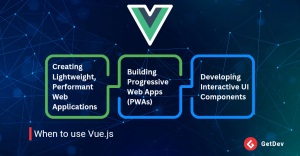
- Creating Lightweight, Performant Web Applications
Vue is perfect for building lightweight, high-performance web applications. Its small bundle size and fast rendering make it ideal for applications that need to load quickly and perform well, even on less powerful devices or slower network connections. Vue is also an excellent choice for single-page applications (SPAs) where responsiveness and speed are critical.
- Building Progressive Web Apps (PWAs)
Vue’s ability to handle dynamic data and its focus on performance make it an excellent choice for building Progressive Web Apps (PWAs). PWAs are web applications that offer native app-like experiences, including offline functionality, fast loading times, and push notifications. With Vue’s simplicity and performance-focused architecture, developers can easily create seamless PWAs that run efficiently across all devices.
- Developing Interactive UI Components
Vue’s reactive data-binding and component-based structure make it an excellent framework for developing interactive UI components. If your project involves building a complex UI with dynamic content, Vue allows you to break down the UI into smaller, reusable components that can respond to user input in real-time. This modular approach makes it easy to manage and update the UI over time.
Developer’s Dilemma: Vue vs. React
If Vue and React were people, Vue would be the chill friend who makes everything easier, while React would be the high-achiever pushing you to be better. React’s approach is more hands-on and opinionated, while Vue is more flexible and allows developers to work at their own pace. Whether you prefer the structured approach of React or the simplicity of Vue, both frameworks offer excellent tools for building modern web applications.
3. Svelte – The Future of Reactive Web Apps
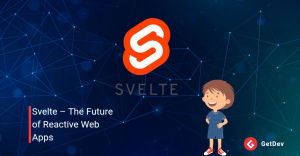
Svelte is revolutionizing the world of reactive web development by taking a radically different approach. Unlike traditional frameworks like React or Vue that rely on a virtual DOM, Svelte compiles components directly into efficient JavaScript code that updates the DOM without the need for a virtual representation. This innovative approach makes Svelte faster and lighter than most modern frameworks, offering developers a way to build high-performance web applications with minimal overhead. As it continues to gain traction in 2025, Svelte is proving to be a game-changer for frontend development.
Why You Should Know It
Svelte offers a breath of fresh air for developers tired of dealing with the complexities and performance overhead of traditional frameworks. One of the key reasons for Svelte’s rapid rise in popularity is its simplicity. Instead of relying on a virtual DOM to track and apply changes, Svelte compiles components into efficient, imperative code that updates the actual DOM directly. This approach eliminates the need for additional overhead and runtime processing, resulting in faster web applications with a smaller file size.
Additionally, Svelte’s syntax is easy to read and intuitive, making it an attractive option for developers looking for a straightforward framework that doesn’t require them to learn an entirely new paradigm. Unlike other frameworks, which often require developers to learn a separate state management library or work with complex state updates, Svelte includes built-in state management that integrates seamlessly with its component structure.
Svelte is rapidly gaining popularity among developers and has already been adopted by major companies for its superior performance and ease of use. If you’re looking for a modern framework that focuses on speed, simplicity, and a more native approach to building reactive applications, Svelte should definitely be on your radar.
Key Features

Svelte introduces several features that make it stand out from other frontend frameworks. These features not only simplify development but also significantly improve performance.
- No Virtual DOM—Direct Updates to the DOM
One of the most significant differences between Svelte and other popular frameworks is its approach to DOM manipulation. Traditional frameworks like React and Vue use a virtual DOM, where updates to the UI are first made in memory and then diffed and applied to the real DOM. Svelte, on the other hand, skips the virtual DOM entirely and compiles components into efficient JavaScript code that updates the DOM directly. This reduces both memory usage and processing time, leading to faster applications with lower overhead.
- Easy-to-Read Syntax
Svelte’s syntax is simple, intuitive, and closer to plain HTML, CSS, and JavaScript, making it easier for developers to pick up and start building. Unlike React or Vue, Svelte does not require special syntax or complex state management methods. Components in Svelte are written in a straightforward way, where you define HTML, CSS, and JavaScript in a single file, with minimal boilerplate. This makes Svelte a great option for developers who want to focus on building rather than managing complicated tooling or configurations.
- Built-in State Management
Svelte comes with built-in state management, which eliminates the need for additional libraries like Redux or Vuex. The framework allows you to create reactive variables that automatically update the DOM whenever the state changes. This built-in reactivity makes it easier to manage application state, especially in smaller projects where setting up a separate state management solution might feel like overkill. The simplicity of Svelte’s reactive system means that developers can focus on building features instead of maintaining complex state management logic.
What’s New in 2025?
Svelte continues to evolve and improve, and 2025 brings several exciting new features that further enhance its capabilities and make it even more appealing to developers.
- Svelte 5 Introduces Reactive Stores with Better Reactivity
Svelte 5 introduces an upgraded version of its reactive stores, offering enhanced reactivity for managing state across components. These reactive stores are now more powerful and flexible, allowing for better control over application state and making it easier to manage more complex data flows. This update enhances Svelte’s already strong reactivity system, making it an even more attractive option for developers building dynamic applications.
- More Seamless Integrations with Backend Frameworks
In 2025, Svelte has focused on making integrations with backend frameworks smoother and more seamless. Whether you’re using Express, Fastify, or another server-side framework, Svelte now provides better tools and support for integrating with backend APIs and services. This makes it easier to create full-stack applications and enables developers to use Svelte as part of a larger, more complex architecture without encountering compatibility issues.
- Improved SSR and Hydration
Svelte has made significant improvements to its Server-Side Rendering (SSR) and hydration capabilities. SSR allows Svelte applications to render on the server and be sent to the client as fully formed HTML, improving load times and SEO. In 2025, Svelte introduces even more efficient SSR techniques and improved hydration, ensuring that pages are interactive and dynamic as soon as they load. This makes Svelte a great choice for performance-focused applications, especially those that require fast loading times and high SEO performance.
When to Use It
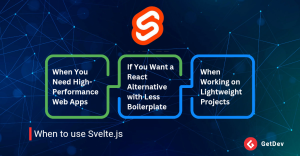
Svelte is an ideal choice for a wide range of web development scenarios, especially when performance and simplicity are top priorities. Here are a few cases where Svelte shines:
- When You Need High-Performance Web Apps
Svelte’s unique approach to DOM manipulation and its lack of a virtual DOM make it one of the fastest frameworks available. If you’re building a high-performance web application that needs to run efficiently on a variety of devices and networks, Svelte is an excellent choice. Its ability to compile to highly optimized JavaScript code means that Svelte apps are lean and fast, even with complex UIs or real-time features.
- If You Want a React Alternative with Less Boilerplate
Svelte is a great alternative to React, especially for developers who want the power of a modern frontend framework without the overhead of JSX, hooks, or complex configuration. Unlike React, which can require a significant amount of boilerplate code, Svelte simplifies the development process by reducing the need for additional state management libraries, hooks, or lifecycle methods. If you prefer a cleaner and more intuitive development experience, Svelte offers a streamlined approach to building reactive web applications.
- When Working on Lightweight Projects
Svelte is perfect for small, lightweight projects where performance is key. Its minimal bundle size and efficient DOM updates make it a great choice for building fast, responsive applications that don’t require the overhead of larger frameworks. Whether you’re building a small website, a single-page app, or a lightweight dashboard, Svelte can deliver excellent performance without the bloat associated with other frameworks.
Industry Insight: Major Companies Are Betting on Svelte
As Svelte continues to gain momentum, major companies are starting to bet on its performance benefits. Its unique approach to web development has proven to be highly effective, especially for high-performance, resource-efficient applications. If you’re looking for a forward-thinking framework that’s pushing the boundaries of what’s possible with reactive web development, Svelte is definitely a framework to watch. Don’t be left behind—consider adopting Svelte for your next project!
4. Next.js – The King of SSR and Performance

Next.js is one of the most powerful frameworks for building React applications, offering an extensive set of tools that optimize performance, SEO, and user experience. As React’s companion, Next.js specializes in server-side rendering (SSR), static site generation (SSG), and API handling, making it a go-to solution for developers who want to build fast, SEO-friendly, and highly performant web applications. Its powerful feature set makes it an ideal choice for everything from static websites to dynamic web apps and eCommerce platforms.
Why You Should Know It
Next.js is indispensable for developers looking to elevate their React applications with features like server-side rendering (SSR), static site generation (SSG), and more. While React is excellent for building dynamic user interfaces, Next.js provides a higher-level abstraction to enhance the React experience, especially when it comes to optimizing performance and handling server-side logic. By providing built-in tools for SSR and SSG, Next.js makes it easy to deliver fast, SEO-friendly content to users without requiring complex configurations or custom setups.
Next.js simplifies the process of building high-performance web applications with features that focus on speed, scalability, and ease of use. Developers can leverage automatic static optimization, hybrid SSR & SSG support, and built-in image optimization for faster loading times. In addition, the framework’s support for edge computing and real-time API handling makes it a versatile option for building advanced applications such as AI-driven tools, real-time streaming platforms, and eCommerce sites.
Key Features
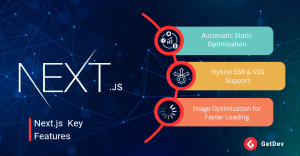
Next.js provides a wealth of features that make it one of the most popular React frameworks. Here are some of the key features that set Next.js apart:
- Automatic Static Optimization
Next.js automatically optimizes pages for static generation when possible, allowing developers to deliver content instantly to users without additional server-side processing. This static optimization leads to faster page loads and enhanced performance, improving the user experience and reducing server load. It’s especially valuable for sites where content does not change often or can be pre-rendered, such as blogs, landing pages, and documentation sites.
- Hybrid SSR & SSG Support
Next.js supports both Server-Side Rendering (SSR) and Static Site Generation (SSG), offering flexibility for developers to choose the rendering method that best suits their project. While SSR enables dynamic content rendering on the server for each request (great for personalized or frequently changing data), SSG generates static content at build time, providing faster load times for pages that don’t require real-time data. Next.js lets developers combine both approaches in a single application, offering a hybrid solution that caters to different needs across various pages and sections of a website.
- Image Optimization for Faster Loading
One of the key features of Next.js is its built-in image optimization capabilities. Next.js automatically optimizes images by serving them in modern formats like WebP and resizing them to the appropriate dimensions based on the device or screen size. This optimization improves page load times, reduces bandwidth usage, and enhances the overall performance of the application. This feature is essential for developers building media-heavy websites, such as blogs, galleries, or eCommerce stores, where image loading times are a critical factor.
What’s New in 2025?
Next.js continues to evolve in 2025, with several exciting new features designed to enhance performance, scalability, and integration with modern technologies.
- Next.js 15 Improves AI-Powered Performance Optimizations
In 2025, Next.js introduces AI-powered performance optimizations in version 15. These new enhancements use machine learning algorithms to predict and optimize key parts of the application, such as resource loading, image sizes, and server-side rendering performance. With these intelligent optimizations, Next.js can automatically adjust configurations to maximize application speed and responsiveness, providing a smoother experience for developers and users alike.
- Better Edge Computing Integration for Ultra-Fast Content Delivery
Next.js has improved its integration with edge computing, enabling content to be delivered from the closest possible server to the user. This reduction in geographical distance between the user and the server decreases latency and ensures ultra-fast content delivery. This is particularly useful for applications that require real-time updates or low-latency interactions, such as global news sites, real-time eCommerce platforms, and interactive web applications.
- Automatic API Caching for Reduced Server Load
To further optimize performance, Next.js 15 introduces automatic API caching. This feature automatically caches responses from APIs, reducing the number of requests that need to be processed by the server and enhancing the speed of dynamic web applications. By caching API responses at the edge, Next.js can deliver content to users more quickly while also minimizing the load on backend servers. This is particularly useful for applications that rely on APIs for real-time data, such as news sites, social media platforms, and live sports scores.
When to Use It
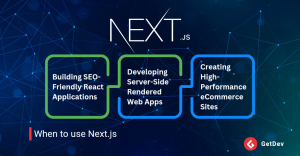
Next.js is a great fit for a wide range of web applications, particularly those that require high performance, SEO optimization, and dynamic content handling. Here are a few situations where Next.js excels:
- Building SEO-Friendly React Applications
Next.js is widely regarded as one of the best frameworks for building SEO-friendly React applications. With built-in server-side rendering (SSR), it allows search engines to index your pages easily by rendering the full content on the server before sending it to the client. This is crucial for applications that rely on SEO to drive traffic, such as blogs, marketing websites, and landing pages.
- Developing Server-Side Rendered Web Apps
If you’re building an application that requires real-time content or personalized data, Next.js is an excellent choice for implementing server-side rendering (SSR). By rendering content on the server for each request, SSR ensures that users see the most up-to-date content while also benefiting from the speed and SEO advantages that come with server-side rendering.
- Creating High-Performance eCommerce Sites
Next.js is particularly well-suited for building high-performance eCommerce websites. With features like automatic static optimization, image optimization, and hybrid rendering support, Next.js can deliver fast, responsive shopping experiences for users. Additionally, the integration with edge computing and automatic API caching ensures that your eCommerce site can handle high traffic volumes and provide a seamless experience to customers worldwide.
Did You Know?
Next.js is not just for traditional web applications—it’s now widely used for building AI-powered applications and real-time streaming platforms. The framework’s combination of performance optimizations, hybrid rendering, and real-time API handling makes it an excellent choice for cutting-edge technologies, such as machine learning apps, real-time chat systems, and live video streaming services. Whether you’re building a modern content-rich website or an advanced, interactive platform, Next.js provides the tools you need to deliver high-performance experiences.
5. Astro – The Rising Star in Web Performance

Astro is quickly becoming a go-to framework for developers who prioritize performance and speed. Designed with static site generation in mind, Astro minimizes JavaScript by default, ensuring that only the essential code is shipped to the browser. This makes it an ideal choice for content-heavy websites, blogs, documentation sites, and other applications where performance and SEO are critical. In 2025, Astro continues to evolve, offering advanced optimizations and integrations to make building fast, SEO-friendly sites even easier.
Why You Should Know It
Astro stands out in the modern web development landscape for its focus on shipping zero JavaScript by default. This unique approach makes it a perfect choice for building fast, static websites that don’t require unnecessary client-side code. By limiting JavaScript to only what’s absolutely necessary, Astro ensures that websites load faster, are more SEO-friendly, and provide a better overall user experience.
In addition to its performance benefits, Astro is flexible enough to support multiple frontend frameworks, including React, Vue, and Svelte. This allows developers to use their preferred tools while still benefiting from Astro’s lightning-fast, minimalistic approach. Astro is also increasingly becoming a popular choice for content-driven applications where SEO and performance optimization are paramount. If you’re building a website that needs to load quickly and be easily discovered by search engines, Astro is a framework that should be on your radar.
Key Features
Astro’s innovative approach to web development introduces several key features that contribute to its speed and flexibility.
- Ships Only Necessary JavaScript
Astro’s core philosophy revolves around delivering only the JavaScript that’s absolutely required for the page. Unlike traditional frameworks that often ship a large amount of JavaScript to manage the UI or components, Astro only includes the JavaScript needed for interactive elements, which results in a faster page load time. By removing unnecessary scripts, Astro significantly reduces the amount of data that needs to be transferred to the client, making it ideal for performance-critical websites.
- Supports Multiple Frontend Frameworks (React, Vue, Svelte)
Astro is designed to work seamlessly with a wide variety of frontend frameworks, allowing developers to choose the tools they’re most comfortable with. Whether you prefer React, Vue, or Svelte, Astro lets you build with your preferred framework while still benefiting from its optimization features. This flexibility enables developers to create highly interactive pages with modern tools without sacrificing speed or performance.
- Ideal for SEO and Performance Optimization
Astro is built with SEO and performance optimization in mind. By default, it generates static HTML content that search engines can easily crawl and index. This makes Astro an excellent choice for building SEO-friendly websites and blogs where page load speed is crucial. Astro’s built-in optimizations—such as reducing the size of the final JavaScript bundle and optimizing assets—help ensure that websites not only load quickly but also rank well in search engine results.
What’s New in 2025?
Astro continues to evolve in 2025, introducing several new features that further enhance its performance, flexibility, and ease of use for developers.
- Better AI-Assisted Site Optimization
Astro 2025 brings AI-assisted site optimization, which helps automate many of the tasks that developers would traditionally handle manually. This includes automatic image optimization, lazy-loading, and other performance improvements based on AI-driven recommendations. By leveraging AI to make real-time performance adjustments, Astro further enhances its already impressive speed and optimization capabilities.
- Faster Hydration Techniques for Improved Interactivity
Hydration, the process of making static content interactive on the client-side, can sometimes be slow and cumbersome. In Astro 2025, hydration techniques have been significantly improved, making the process faster and smoother. This means that websites built with Astro can now offer better interactivity and responsiveness without sacrificing the performance benefits of static rendering. Whether you’re building a dynamic blog or an interactive eCommerce site, these improvements ensure that Astro-based websites are both fast and engaging.
- More CMS Integrations
In 2025, Astro expands its support for CMS (Content Management System) integrations, making it easier to build content-driven sites with platforms like WordPress, Contentful, and others. These integrations allow developers to easily manage dynamic content without losing the performance benefits of static site generation. Now, developers can take advantage of Astro’s speed while still using the content management tools that fit their needs.
When to Use It
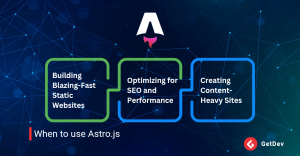
Astro is perfect for a variety of web development scenarios, particularly those where performance, SEO, and speed are top priorities. Here are a few use cases where Astro excels:
- Building Blazing-Fast Static Websites
Astro is a top choice for building static websites that need to load as quickly as possible. By reducing JavaScript and generating static HTML at build time, Astro ensures that your website delivers content to users almost instantaneously. Whether you’re building a portfolio, documentation site, or landing page, Astro is ideal for delivering a fast, streamlined user experience.
- Optimizing for SEO and Performance
For developers looking to build SEO-friendly websites that rank well in search engine results, Astro is a great option. Its focus on static site generation, minimal JavaScript, and fast loading times all contribute to better SEO performance. By ensuring that search engines can easily crawl and index your content, Astro helps your website get discovered while also providing a better experience for users.
- Creating Content-Heavy Sites
Astro is well-suited for content-heavy websites like blogs, news sites, or media-rich platforms. With Astro, you can efficiently manage large amounts of content while ensuring that performance remains high. The framework’s static generation and optimization features allow you to create content-rich websites that load quickly, even when packed with images, videos, and other media.
Fastest Framework in Town?
Astro proves that sometimes less is more. By shipping only the essential JavaScript and focusing on static site generation, it delivers blazing-fast websites that excel in performance. If you’re looking for a framework that prioritizes speed and simplicity, Astro may just be the fastest and most efficient choice available.
6. Three.js – The Future of 3D Web Development
Three.js is a powerful and versatile JavaScript library that brings 3D graphics to the web using WebGL. With its ability to create immersive 3D environments, Three.js is a must-know tool for anyone working on gaming, virtual reality (VR), augmented reality (AR), or interactive 3D interfaces. As the web continues to evolve, Three.js is at the forefront of making 3D content more accessible and performant, providing developers with the tools needed to create rich, interactive experiences directly within the browser.
Why You Should Know It
Three.js allows developers to create sophisticated 3D content that runs smoothly in web browsers, leveraging WebGL for hardware-accelerated graphics. Its broad range of features and support for various 3D elements such as scenes, lighting, and animations makes it an indispensable tool for anyone working in industries like gaming, VR, AR, and data visualization. Whether you’re designing complex 3D models for interactive websites or building fully immersive virtual experiences, Three.js gives you the flexibility and power to turn your ideas into reality.
The library simplifies the often-complex task of working with 3D graphics, making it accessible even to developers with limited experience in graphics programming. By abstracting away many of the low-level details of WebGL, Three.js lets developers focus on the creative aspects of 3D development, such as scene composition, camera positioning, and lighting effects, all while ensuring high performance and cross-browser compatibility.
Key Features
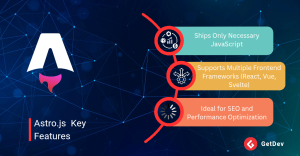
Three.js offers a wealth of features that enable the creation of dynamic, interactive 3D content directly within the browser. Here are some of the key features that make Three.js so powerful:
- Cross-Browser WebGL Support
Three.js is built on top of WebGL, which ensures that 3D content can be rendered across all major browsers without requiring additional plugins. WebGL provides hardware-accelerated graphics, allowing complex 3D scenes to be rendered efficiently on any device with a compatible browser. With Three.js, you can create 3D applications that work seamlessly across different platforms, from desktops to mobile devices, with minimal effort.
- Scene, Lighting, and Animation Support
Three.js provides robust support for creating dynamic 3D scenes, with full control over lighting, shadows, and animations. You can set up realistic lighting effects to enhance the atmosphere of your 3D environments, create shadows for depth, and implement animations to bring your scenes to life. Whether you’re building a simple 3D object viewer or a complex interactive simulation, Three.js includes everything you need to craft immersive experiences.
- Efficient GPU Rendering
Rendering 3D graphics can be computationally expensive, but Three.js optimizes performance by efficiently utilizing the GPU (Graphics Processing Unit). The library’s rendering engine is designed to leverage the full power of the GPU, enabling the creation of high-quality 3D scenes without sacrificing performance. This is particularly important for creating real-time applications like games, simulations, and VR experiences, where smooth performance is crucial for a good user experience.
What’s New in 2025?
Three.js continues to evolve and improve, introducing new features and performance enhancements in 2025. These updates make it easier for developers to create high-quality 3D content and push the boundaries of what’s possible on the web.
- Better AI-Driven Animation Tools
In 2025, Three.js introduces improved AI-driven animation tools that make it easier to create dynamic, lifelike animations for 3D models. These tools leverage machine learning algorithms to automate certain animation tasks, such as character rigging, motion prediction, and physics-based movement. This enhancement streamlines the animation process, allowing developers to create more complex and realistic animations with less effort.
- Faster Rendering Engine
Performance is always a priority in 3D development, and Three.js continues to improve its rendering engine to provide faster performance. With the latest updates, Three.js features a more efficient rendering pipeline that reduces the time it takes to render complex 3D scenes. This means smoother interactions, quicker load times, and better performance across all devices, including lower-powered mobile devices and laptops.
- New AR/VR Support
In 2025, Three.js expands its capabilities by adding enhanced support for augmented reality (AR) and virtual reality (VR). These updates make it easier for developers to create immersive AR and VR experiences directly within the browser, without the need for specialized apps or plugins. Whether you’re building a VR game, an interactive 3D model viewer, or an AR experience, Three.js now provides the tools necessary to bring these cutting-edge technologies to the web.
When to Use It
Three.js is ideal for projects where 3D rendering, interactivity, and high performance are key. Here are some of the best use cases for Three.js:
- Building 3D Web Applications
Three.js is perfect for creating 3D web applications, whether you’re designing a complex simulation, a virtual tour, or a game. The library’s support for scene management, lighting, and rendering makes it an excellent choice for building interactive 3D applications that run directly in the browser. Its ease of use and flexibility allow developers to bring 3D content to life in ways that were previously only possible in dedicated software or standalone applications.
- Creating Interactive Visualizations
For developers working with data, Three.js is an excellent tool for creating interactive 3D visualizations. Whether you’re visualizing scientific data, architectural designs, or geographic information, Three.js provides the necessary features to create engaging and informative 3D charts, graphs, and maps. Its ability to handle large datasets and provide real-time interactivity makes it an ideal choice for building data-driven visual experiences.
- Developing VR and AR Experiences
With its support for VR and AR, Three.js is an ideal choice for building immersive, interactive virtual experiences. Whether you’re designing a VR game, an AR app, or a 3D training simulation, Three.js offers the flexibility and power needed to create high-quality, browser-based immersive environments. The recent improvements in AR/VR support in 2025 make it easier than ever to create these types of experiences without requiring external plugins or applications.
The Metaverse Might Have Flopped, but 3D on the Web is Here to Stay!
While the broader metaverse may have faced challenges, 3D web development is becoming more integrated and impactful than ever. Three.js is at the forefront of this shift, empowering developers to create interactive, high-performance 3D experiences directly in the browser. Whether you’re building the next big VR game, an interactive data visualization, or a web-based 3D art installation, Three.js provides the tools to bring your 3D ideas to life in ways that were previously unimaginable for web-based applications. The future of 3D on the web is bright, and Three.js is leading the way.
7. D3.js – Data Visualization Made Easy
D3.js is the undisputed leader when it comes to creating complex data visualizations on the web. As the premier JavaScript library for data visualization, it empowers developers to bring data to life with stunning, interactive graphics. In 2025, D3.js remains a crucial tool for anyone working with data, offering the flexibility and power needed to create highly customizable and dynamic visual representations of information. Whether you’re working on small-scale charts or large, intricate data visualizations, D3.js gives you the control to transform data into engaging visual stories.
Why You Should Know It
D3.js (Data-Driven Documents) remains one of the most powerful and versatile libraries for visualizing data on the web. It enables developers to bind data to HTML, SVG, or Canvas elements, allowing for the creation of complex, interactive, and data-driven visualizations. With D3.js, you can build everything from simple bar charts to complex, interactive data dashboards. Its emphasis on flexibility and control over the visual presentation makes it the go-to library for creating data visualizations that can be customized to any level of detail.
What makes D3.js particularly valuable is its data-driven approach to visualization. It allows you to map data to visual properties like color, position, size, and shape, making it an ideal tool for representing intricate relationships within large datasets. Moreover, with the integration of interactivity and animations, D3.js helps create compelling and informative visual experiences that engage users, making complex data more accessible and easier to understand.
Key Features
D3.js offers a wide range of features that set it apart as the industry standard for data visualization. These features make it highly customizable and capable of handling complex data visualization needs.
- SVG, Canvas, and HTML Integration
D3.js allows you to create visualizations using various web technologies, including SVG (Scalable Vector Graphics), Canvas, and HTML. This flexibility gives you the freedom to choose the best rendering method for your project, depending on factors such as the complexity of the visualization, the need for interactivity, and performance considerations. SVG is great for high-quality vector graphics and interactive elements, while Canvas can be used for rendering more performance-intensive graphics, such as those involving large datasets.
- Data-Driven Transformations
At the core of D3.js is its ability to bind data to DOM elements and dynamically generate visual elements based on that data. This means that you can create responsive and data-driven transformations where the appearance and behavior of the elements change automatically when the data changes. Whether you’re updating a bar chart, creating animated transitions, or modifying the layout of a visualization, D3.js makes it easy to create highly interactive, data-driven visualizations that reflect real-time data changes.
- Interactive Visualizations
D3.js excels in creating interactive visualizations, which is one of its most powerful features. With D3.js, developers can implement interactive elements such as tooltips, zooming, panning, filtering, and click events to enhance user engagement. These interactions allow users to explore data more deeply, whether that’s by hovering over a data point to view additional information or dragging to zoom in on a specific area of a chart. The interactivity provided by D3.js elevates the data visualization experience and helps make complex data more digestible.
When to Use It
D3.js is perfect for projects that require sophisticated data visualizations and interactive charts. Here are some of the best use cases for D3.js:
- Creating Charts, Graphs, and Dashboards
D3.js is ideal for building a wide range of visualizations, including bar charts, line graphs, pie charts, and dashboards. Its flexibility allows for highly customized, tailored visualizations that can reflect the specific needs of your dataset. Whether you’re designing simple charts or comprehensive dashboards, D3.js can create visually appealing and functional data representations.
- Visualizing Big Data
For projects involving large datasets, D3.js provides powerful tools to handle and visualize vast amounts of data effectively. D3.js can be used to represent complex datasets, showing patterns and trends that may not be immediately obvious. Thanks to its data-driven transformations and ability to handle dynamic updates, D3.js makes it easy to create scalable and efficient visualizations that can represent large amounts of data in a comprehensible way.
- Building Interactive Analytics Tools
D3.js is also excellent for creating interactive analytics tools, such as data exploration platforms, real-time data monitors, or business intelligence dashboards. By integrating interactive elements, users can drill down into the data, customize their view, or explore relationships between different variables. D3.js provides all the features needed to create powerful, interactive analytics tools that allow users to derive insights from complex datasets.
The Power of Data Visualization with D3.js
D3.js continues to be the ultimate tool for developers who want to turn raw data into interactive, visually appealing graphics. Its ability to create data-driven visualizations with complete control over every aspect of the design has solidified its place as the go-to library for data visualization. Whether you’re building simple charts, complex visualizations, or interactive analytics platforms, D3.js remains the top choice for turning data into compelling stories on the web.
8. Chart.js – Simpler Data Visualization
Chart.js is a lightweight and easy-to-use JavaScript library that provides a simpler approach to creating beautiful, interactive charts for your web applications. It’s a great alternative to more complex libraries like D3.js, particularly for developers who want quick and straightforward charting solutions. As a popular tool for creating visually appealing data visualizations, Chart.js is ideal for projects where simplicity and ease of integration are key. With its minimalistic approach, Chart.js allows you to create professional-looking charts in no time without the steep learning curve.
Why You Should Know It
For developers looking for a simple and elegant way to implement data visualizations, Chart.js is a fantastic option. Unlike more complex libraries like D3.js, which can require an in-depth understanding of data binding and low-level graphics programming, Chart.js offers a straightforward API that allows you to generate charts with just a few lines of code. Its simplicity makes it particularly useful for developers who want to quickly add charts to their projects without the overhead of complex configuration.
Chart.js is ideal for small to medium-sized data visualization tasks. It handles a wide variety of chart types out of the box and offers good performance for most common use cases. Whether you’re building a small business dashboard or adding visual data elements to a website, Chart.js lets you create professional-looking charts with ease, making it a go-to tool for quick data visualization needs.
Key Features
Chart.js is packed with features that allow developers to create a variety of chart types with minimal effort. Here are some of the standout features that make Chart.js so popular:
- Simple API for Quick Chart Creation
The core strength of Chart.js is its simple and intuitive API, which allows developers to create charts quickly and easily. All you need is a few lines of JavaScript code to generate basic charts such as line graphs, bar charts, or pie charts. The straightforward API means you can integrate charts into your applications without spending a lot of time learning complex syntax or structures. This simplicity makes Chart.js an excellent choice for quick prototyping and smaller projects.
- Supports Multiple Chart Types
Chart.js offers support for a wide range of chart types, including line charts, bar charts, radar charts, doughnut charts, pie charts, and more. It also allows you to create mixed charts that combine different types of visualizations into one, such as combining line and bar charts. This flexibility means that you can use Chart.js to build a variety of visualizations to meet different data presentation needs, from basic reports to more complex interactive displays.
- Works with Vanilla JavaScript and Frameworks
Chart.js is lightweight and works well with vanilla JavaScript, but it’s also compatible with popular frameworks and libraries like React, Angular, and Vue.js. This flexibility makes it easy to integrate into various types of web applications, whether you’re building a simple static site or a more complex, data-heavy app. Chart.js can seamlessly work in both traditional and modern web development environments.
When to Use It
Chart.js is ideal for developers who need to quickly create interactive, simple data visualizations without the complexity of other libraries. Below are some of the best scenarios where Chart.js excels:
- Creating Charts, Graphs, and Dashboards
Whether you’re designing a data dashboard, reporting tool, or simple analytics application, Chart.js offers an easy way to add charts to your project. It’s particularly great for creating line charts, bar charts, and pie charts, which are common elements in business dashboards and reporting applications. The ability to quickly generate charts with simple code means you can spend more time focusing on your application’s core functionality.
- Visualizing Medium-Scale Data
Chart.js is perfect for visualizing medium-sized datasets that don’t require the complexity of advanced data transformations. If you have data that’s straightforward to visualize, like user activity statistics, sales data, or product performance metrics, Chart.js is an excellent tool to bring that data to life without overcomplicating the process.
- Integrating with Existing Web Applications
Chart.js works well with both traditional JavaScript apps and modern front-end frameworks, making it easy to integrate into an existing application. Whether you’re enhancing an existing website with basic charts or integrating visualizations into a complex web app, Chart.js provides an accessible, flexible solution.
9. Node.js – The Backend JavaScript Workhorse
Node.js is an open-source, cross-platform JavaScript runtime that enables developers to run JavaScript code on the server-side, making it a powerful tool for full-stack development. It is 9particularly popular for building scalable, event-driven applications such as real-time web apps, APIs, and microservices. Node.js helps bridge the gap between front-end and back-end development, allowing developers to use the same programming language (JavaScript) for both sides of the stack.
Why You Should Know It
Node.js is a game-changer for developers who want to write both client-side and server-side code in JavaScript. By leveraging JavaScript on the backend, Node.js allows for full-stack development with a unified language across the stack. Node.js is built on an asynchronous, event-driven architecture, making it ideal for handling numerous simultaneous connections, such as those found in real-time web applications, chat systems, and online gaming.
Thanks to its non-blocking I/O, Node.js excels at handling large volumes of requests concurrently, making it particularly effective for building high-performance APIs, microservices, and scalable web applications. Additionally, the vast npm (Node Package Manager) ecosystem provides access to thousands of libraries and tools, further accelerating development time.
Key Features
Node.js provides several key features that make it the go-to choice for backend development:
- Asynchronous, Event-Driven Architecture
Node.js uses a non-blocking, event-driven architecture, which allows it to handle multiple operations concurrently without waiting for each one to finish. This makes Node.js highly efficient for building applications that require real-time interaction or need to process a large number of requests simultaneously, such as chat apps, live data feeds, and gaming platforms.
- Supports Microservices and APIs
Node.js is well-suited for building microservices architectures, where an application is broken down into smaller, independently deployable services. This approach improves scalability and maintainability. Additionally, Node.js provides robust support for building APIs, making it a popular choice for developers working with RESTful APIs, GraphQL, and WebSocket-based real-time communication.
- Huge Package Ecosystem (npm)
Node.js has one of the largest package ecosystems in the programming world. npm (Node Package Manager) gives developers access to a massive number of libraries and tools that make it easy to add functionality to their projects. From authentication libraries to database connectors, Node.js developers can quickly integrate third-party tools and accelerate development.
10. TensorFlow.js – AI Meets JavaScript
TensorFlow.js brings machine learning (ML) to the JavaScript ecosystem, allowing developers to train and deploy machine learning models directly in the browser or on Node.js. With TensorFlow.js, JavaScript developers can build and run sophisticated AI models without the need for complex setups or specialized languages.
Why You Should Know It
As artificial intelligence continues to transform industries, TensorFlow.js makes it easier than ever for web developers to harness the power of machine learning within their applications. With TensorFlow.js, developers can run AI models directly in the browser or on the server using Node.js, making it an invaluable tool for real-time data processing, recommendation engines, image recognition, and more.
TensorFlow.js also allows developers to build custom models and fine-tune existing pre-trained models, bringing the power of machine learning to JavaScript-powered applications. Its integration with both front-end and back-end development makes TensorFlow.js a versatile tool for adding AI capabilities to a wide range of applications.
Key Features
- Train and Deploy ML Models in JavaScript
With TensorFlow.js, you can build and train machine learning models entirely in JavaScript. This makes it easy to integrate AI capabilities into web apps without needing to switch to specialized languages like Python. You can also deploy pre-trained models or fine-tune them to meet the specific needs of your application.
- GPU-Accelerated Performance
TensorFlow.js leverages WebGL for GPU-accelerated performance, allowing developers to run complex machine learning models directly in the browser with impressive speed. By taking advantage of hardware acceleration, TensorFlow.js ensures that AI tasks can be handled quickly and efficiently, even on devices with limited computational power.
- Works with WebGL and Node.js
TensorFlow.js is highly versatile, working both in the browser using WebGL for GPU acceleration and on the server with Node.js. This flexibility means that you can run machine learning models directly in the browser for real-time processing, or use Node.js to process data server-side for more resource-intensive tasks. Whether you need AI capabilities in a browser-based app or on the server, TensorFlow.js provides a seamless solution.
Conclusion
Mastering JavaScript libraries in 2025 is crucial for any developer looking to stay competitive in the ever-evolving landscape of web development. The right tool can make all the difference when it comes to building efficient, scalable, and interactive applications. From frontend frameworks to backend powerhouses, the JavaScript ecosystem is more diverse than ever, offering a wide variety of libraries to suit every development need. Whether you’re working on complex user interfaces, high-performance backend services, or cutting-edge AI-driven applications, there’s a library in this list that can help you streamline your development process and take your projects to the next level.
As we move further into 2025, it’s important to stay up-to-date with the latest innovations in JavaScript libraries. With the rapid advancements in areas like artificial intelligence, data visualization, and real-time web applications, mastering the tools that enable these technologies is essential for modern developers. Each of the 10 libraries mentioned—whether you’re using Chart.js for easy-to-implement data visualization, TensorFlow.js for machine learning in the browser, or Node.js for building efficient backend services—provides unique advantages that cater to specific challenges you might face in development.
Adopting the best libraries for your projects can significantly enhance your workflow,